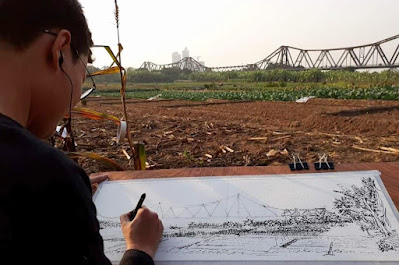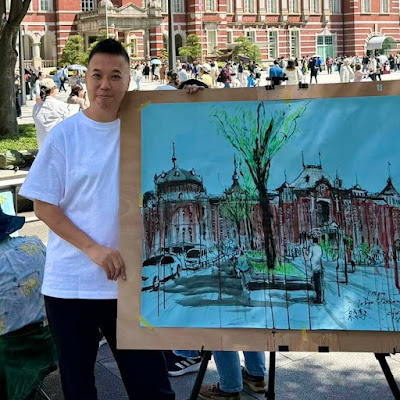Meet Your USkJ Friends: Hai
とってもお久しぶりのMeet Your USkJ Friendsです。インタビュー形式でUSkJメンバーを紹介するこの企画は、もともと2020年、パンデミックで対面することが制限されるなかでもメンバー同士を知り合い、繋がりを保とうという目的で始まりました。現在、状況は改善してきており、スケッチ会も少しずつ再開しています。当初の企画の役割が終わりつつある一方、グループの活動再開に伴い、新たなメンバーが増えています。せっかくですから彼らのことも紹介したい。もっと知りたい。ということで、今回はこの春来日された、日本の近代建築大好きなベトナム出身のHaiさんのインタビューです。毎度ながら英語でいただいた回答をわたしが簡単に訳しています。ぜひお楽しみください〜。
Finally, a new episode of Meet Your USkJ Friends! We started this series of interviews with USkJ members in 2020. Originally, the purpose was to get to know more about each other and stay connected even when we were physically apart because of the pandemic. Now, fortunately, the situation is more under control and we are slowly resuming in-person activities. But, as the group is becoming active again, we are getting new members and I thought it would be a good time to introduce them. So, here's an interview with one of new USkj friends, Hai. He's a skilled sketcher from Vietnam who studied architecture. Hope you enjoy!
---------------------
1: When did you start sketching? How did you get involved in the USk community?
スケッチを始めたのはいつ?またUSk参加の経緯は?
Well I guess 13 years ago I started sketching when I was an architectural student, but it hadn’t been Urban Sketching yet.
By chance, around 7 years ago, I saw a group of enjoyable locals sitting on ground, on stools. They drew streets, buildings, people,… whatever in front of their eyes with a free style of drawing, that was totally different to my sketching style at that time. Their style was more casual and lively than my academically boring one. Ever since then, I’ve gradually switched to Urban Sketching style.
スケッチを始めたのは建築を学ぶ学生だった13年前だと思いますが、その頃はまだアーバンスケッチではありませんでした。
7年くらい前にたまたま地面や椅子に座っている楽しげな地元の人たちのグループを見かけました。彼らは通りや建物、人々……目に映るいろんなものを自由なスタイルで描いていて、当時の自分のスタイルとはまるで違いました。彼らのスタイルは自分のアカデミックでつまらないものよりもカジュアルで生き生きしていました。それから自分のスタイルは徐々にアーバンスケッチに変わっていきました。
 |
| Sketch in Hanoi/ベトナム・ハノイのスケッチ |
2: What do you like to sketch (people, architecture, nature, etc.)?
何をスケッチするのが好き?(人、建築、自然等)
I like to sketch Architecture mainly, it’s likely to be an “occupational obsession” I guess lol. Before I preferred old buildings to the new ones, but now vice versa. I think I’d change my favorite again in a not-so-far future.
主に建築のスケッチが好きです。「職業病」みたいなものだと思います笑。以前は新しいよりも古い建物が好きでしたが、今は逆です。そう遠くない将来にまた自分の好みが変わるだろうなと思っています。
 |
| Interior of the National Art Center in Tokyo/国立新美術館 |
3: Show us your favorite sketch done in Japan and tell us about it.
日本で描いたスケッチでお気に入りを紹介して。
Tokyo, Nakagin Capsule Tower
1972 – 2022
Kurokawa Kisho
中銀カプセルタワー、東京(1972-2022)
黒川紀章設計
This is a sketch of Nakagin Capsule Tower.
I visited this building at its very last moment, a few days before its demolition. Watching and sketching with my bare eyes a legendary building which appeared in my university textbook 10 years ago brought to me a hard-to-say feeling, maybe the mix of nostalgia and amazement.
I was quite surprised that many visitors, young, middle-aged people, the elderly, came there to record, to watch or simply to have a moment with the building for the last time. Everyone coming quietly with regrets for one of Japanese Architecture’s symbols did touch me.
これは中銀カプセルタワーのスケッチです。取り壊しの数日前、この建物の最後の最後の瞬間に訪れて描きました。10年前、大学の教科書に載っていた伝説的な建物を、自分の目で見てスケッチするのは、言葉にできない感覚でした。ノスタルジーと感動が混ざったかんじです。
若者から中年、お年寄りまで、たくさんの人がやってきて、この建物の最後の時を記録したり、眺めたり、純粋にその瞬間を味わったりしているのを見て、とても驚きました。日本の代表的な建築物がなくなる悲しみを携えて粛々とやってくる人々に心を打たれました。
4: Name your favorite sketcher(s) if any.
好きなスケッチャーを教えて。
He was Phong Khieu, a local sketcher I’ve mentioned above. He wasn’t well known but he was a friend of many sketchers in Vietnam and Asia. He sketched fast, captured subjects quickly and accurately. His linework was strong and determined, that was contrary to his humble attitude.
Phong Khieuです。上述の地元のスケッチャーの一人です。彼はそんなに有名ではありませんが、ベトナムやアジアの多くのスケッチャーの友人でした。彼は速描きで、対象をささっと正確に捉えます。謙虚な性格とは対照的に、彼の描く線は力強いです。
Above was one of Phong Khieu’s sketches in Hanoi.
これはPhong Khieuのハノイでのスケッチです。
5: Show us your sketch kit (sketchbook, pen, watercolor, etc.)
スケッチキットを見せて。(スケッチブック、ペン、水彩等)
Here is my favorite sketching kit for now. A6 notebook (or B5 for more detailed sketches), Platinum Century #3776 fountain with M nib that I find very reliable through years, marker pen for thicker strokes and some color pencils.
I always try to make my kit as compact as possible, trying to utilize the simple tools and focus on experiencing the location.
これが今のお気に入りのスケッチキットです。A6のノート(細かいスケッチにはB5)、何年も使用し、頼りにしているプラチナ万年筆の#3776 センチュリー(ニブM)、太い線を引くためのマーカー、そして色鉛筆を何本か。
いつもスケッチキットはできるだけコンパクトにし、シンプルな道具を活用して、その場を味わうことに集中できるようにしています。
6: What has urban sketch brought to your life?
アーバンスケッチがあなたの暮らしにもたらしたものは?
This is such a big question indeed!
I personally think experience is most valuable, and thanks to Urban Sketching, now I could record it through my eyes directly on paper.
I have taken many photos, and most of them go amiss, I rarely see them again; but with sketches, they are different. Every time I look at a sketch again, atmosphere, surroundings, and even details could be recalled together. Also, it’s very helpful for my occupation in building up my personal architecture database as well.
これは大きな問いですね!
僕は経験に何よりも価値があると思いますが、アーバンスケッチのおかげで、経験したことを自分の目を通して直接紙に残すことができます。
写真もたくさん撮ってきましたが、だいたいうまくいきません。写真はほとんど見返すことがないので。でもスケッチは違います。スケッチを見返すと、その場の雰囲気、環境、細部のいろんなことが一緒に思い出されます。それと仕事面でもとても役に立っていて、自分の建築データベースを構築する助けにもなります。
 |
| Miura, Joga Island, Horseback/三浦、城ヶ島、馬の背 |
7: You like Japanese modern architecture. Why does it attract you? Is there any particular building you would like to sketch next?
日本の近代建築がお好きですが、どこに魅力を感じますか?次にスケッチしてみたい日本の建物は?
Yes, I like Japanese Modern Architecture, this is the reason why I’m here actually.
To say, Japan has a very special geographic location, pretty isolated to the continent and frequently suffering from natural disasters. Especially after WW II, with the disadvantage background, there were more and more challenges for Japan to overcome the difficulties. But they did well, even magically.
Many prominent Japanese architects rose in the post-war period also. They did not only copy what the West had done, but also exposed Japanese culture and spirit through architecture, not only for domestic needs but also for international recognition. Even some architectural movements initiated by Japanese architects were ahead of its time, and we still could see some features of theirs nowadays.
The specific context and characteristics above attract me.
はい、日本のモダニズム建築が好きです。今日本にいる理由もそこにあります。
日本は地理的にとても特別な位置にあります。大陸から切り離され、自然災害が多い。こうした不利な状況に加えて、第二次大戦後はさらにいろんな困難が日本に降りかかりました。でも日本の人々は見事に、魔法みたいに、それを乗り越えました。
多くの著名な日本人建築家も戦後に登場しました。彼らは西洋で行われてきたことを真似するだけではなく、日本の文化や精神を、建築を通して表出しました。それは日本国内のニーズを満たすだけではなく、国際的な評価も得るものでした。日本人建築家が始めたムーブメントのいくつかは時代の先を行っていて、今の時代の建築にも当時の特徴が見られたりするのです。
こうした独自の背景や特徴に魅力を感じます。
St. Mary’s Cathedral designed by Tange Kenzo 丹下健三 and The National Museum of Western Art designed by Le Corbusier in Tokyo are 2 next buildings I would want to spend hours with.
Le Corbusier could be seen as the father of Modern Architectural philosophy, while Tange Kenzo – one of the founders of Japanese Modern Architecture, master of many noted architects in Japan. Tange Kenzo was influenced by Le Corbusier also.
丹下健三が設計した東京カテドラル聖マリア大聖堂と、ル・コルビュジエが設計した国立西洋美術館は、時間をかけてスケッチしたい建物です。
ル・コルビュジエはモダニズム建築の哲学の父とされ、丹下健三は日本のモダニズム建築の創始者の一人で、日本の多くの有名な建築家の師と言える人です。丹下健三もル・コルビュジエの影響を受けています。
---------------------
今回もとっても充実したインタビューになりました。わたしは建築の基礎も何も知らないので、最後の日本の近代建築のパートは翻訳しながら勉強になりましたね……笑。中銀カプセルタワーのように、国際的にも価値が認められながら時代とともに取り壊される建物もあるので、今残っている貴重な建築物はきちんと記録と記憶に残したいですね。そして、それを可能にし、今ここの体験を形に残すことができるのが、まさにアーバンスケッチなんだということを、このインタビューを通して改めて感じました。久しぶりのMeet Your USkJ Friends、お読みいただきありがとうございました。また近いうちに別のインタビューを掲載する見込みです。そちらもお楽しみに!
Hope you enjoyed the interview. I personally find his sharing very interesting. Particularly I learned about Japanese Modern Architecture while translating the text since I’m not familiar with architecture at all. Some buildings such as Nakagin Capsule Tower are demolished as they age even though they have international recognition. So, we should keep them in record and memory while they exist. Through the interview, I also relearned urban sketching enables us to do that and capture “life” in a tangible way. This is the new episode of Meet Your USkJ Friends we published for the first time in a long time, but I’m planning to have another interview later. Thanks for reading. See you in the next post!








Comments
Post a Comment